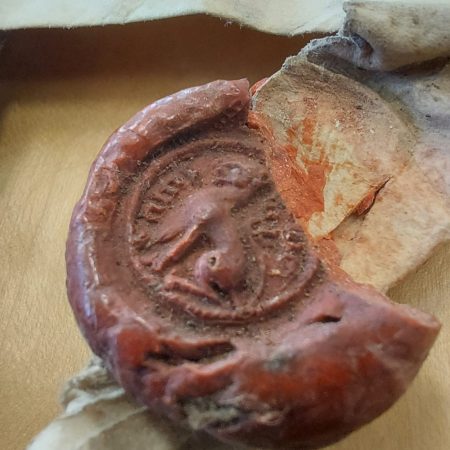While much of the research conducted in archives focuses on documents, maps, photographs, and audio/visual recordings, it is important to recognise the significant value that of wax seals. These small, but important, items can unlock a wealth of information in the field of material research and should not be overlooked or underestimated. Wax seals have been used for centuries for multiple purposes including to authenticate, simply to seal and also serve as a means of communication to convey their owner across literate and illiterate people.
Inspecting and studying these seals, whether they are attached to their original document or not, can provide insightful findings and can extend research, bringing with it specific terminology focused on their study. Examples of the phrases and terms used in studying seals can be found throughout this blog. They can reveal information about the individuals, institutions, and offices involved in the creation and exchange of many different types of documents and provide a tangible connection to their making. However, despite seals possibly being thought to be stereotypical aspects of medieval documents, they can be found in archival documents up to and including more recent centuries.
Seals were typically made by melting wax and then impressing a stamp as the wax was soft before hardening. The stamp used is referred to as a ‘matrix’, or matrices. Although this term is still applicable in later centuries, the more commonly used term ‘stamp’ or ‘die’ is more often used for those used during the 18th century.
When it comes to the wax, however, this would have been different to the novelty sealing wax you can buy today. The wax would have been made from a mixture of beeswax, an ingredient acting as a pigment, and at times a form of turpentine/resin. However, sealing practices in Britain developed and altered through time. One type of practice includes wafer seals ,which appeared during the 17th century in Britain and in colonial New England. A small disc would then have been softened and used to simply seal. Often these were used instead due to convenience rather than the process of sealing wax.
The ‘typical’ seal, however, is known as a pendant seal. This took a variety of shapes, and at times could be different despite belonging to the same person, and often bearing one or more from a wide range of motifs. Shapes range from round, pointed oval shapes (called ‘vesica’) to square, lozenge shapes (diamond) and shield shaped seals. There are even polygonal seals, including hexagonal and octagonal shapes. Vesica seals are often thought be solely borne by ecclesiastical and female owners, however, this is certainly not the case and is a common misconception. Many non-ecclesiastical men and even secular institutions used this shape. This is a principal example of how seals can be unique from person to person without hindrance of rules across shape or motif. For example, held in The National Archives is a seal once belonging to Hugh de Hupcherche, a fishmonger of London which is vesica shaped. Despite being owned by a fishmonger, the seal itself bears the motif of a two-legged dog-like beast.
Types of seals that may be owned by the same person can range and include seals such as a general-use matrix, if someone holds an official office they may have a matrix for that office, and a ‘secret’/’secretum’ seal, which may be used for sealing letters but not exclusively. Additionally, when later heraldic developments occurred with the addition of helms and crowns, nobles, and others of high status can be found to have owned one or more signet rings, each bearing parts or full aspects of their family heraldry.
Looking at the design of seal impressions, these usually, but not always, bear a legend following clockwise from the top. Typically, however, these usually carry motifs. Well known motifs range from equestrian images used by royalty, as well as high-ranking medieval nobles. Examples of these range from depictions of a person on their horse, not always donning armour, to heraldry through simple shields. However, many motifs do not directly pertain to a noble or a person’s place in society. This was because simple or decorated initials and a variety of animals are two of many commonly used motifs utilised during the medieval period.
Not all seals survive today and even those that do are commonly bearing levels of damage. This can be because they have been moved around from place to place if archives move location. Nevertheless, contemporary methods of preservation have had a positive impact on how seals are kept and maintained which typically involve cotton bags. However, at times seals can be found to be kept within their original covers which can include linen bags, skippets, which are metal containers for wax seals, and boxes, which are slightly more uncommon however store documents which are rolled up bearing pendant seals.
Research of seals can open new dimensions of research at an archive with many more aspects and larger available to be learnt. Nevertheless, seals are not always included in an archive’s catalogue. This is because adding these to a catalogue is a large scale and sometimes strenuous task stemming from the process requiring the recording of a multitude of aspects including size, describing the motif displayed, condition, colour, and more. Unfortunately resulting in interesting and curious seals being often come upon when researching the documents they are attached to.
A grant made in August 1446, held in the Hampshire Archives is a great example. The grant concerns a number of manors and other premises from a handful of nobles and members of the gentry to John Roger and Ann Echyngham, his wife. Only four of the five seals survive, and even then, their details are not especially discernible. Despite this, one stands out as being relatively uncommon and unique.
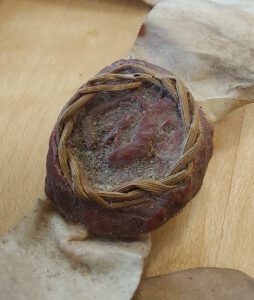
Hampshire Archives: 57M78/E/T96 – Second attached, small pendant seal.
The seal is surrounded by a ‘rush guard’. This is an interwoven guard made of grass or straw embedded into the wax in the pursuit of protecting it. In this case, three blades of now dried grass. It is a small and relatively uncommon aspect of sealing, making it a very curious seal to come across. Especially as it is not often you find medieval grass in an archive! We can see that the rush guard has warped the centre of the seal off, (as they commonly do), however the initial ‘W’ can be seen. This means that this seal likely belonged to William Warbleton, one of the grantors.
An example of how seals can survive with good detail and bear animal motifs can be found attached to a document in the same collection as the previous document.

Hampshire Archives: 57M78/E/T98– Second attached small pendant seal, damaged, though bearing a surviving motif.
This document is a declaration, signed by John Newburgh, Walter Portman and Thomas Hardegrave, acknowledging and promising that the prior document was made under the will of the mentioned John Roger. This seal, belonging to Walter Portman, bears a clear and surviving motif of a cat – a pretty rare motif among animal images. It might be suggested that seals, like heraldry, were direct representations of aspects of the owner or their interests, however it’s likely that people used seal designs that they simply liked.
Attached to the same document is the seal of John Newburgh, although not including an animal motif and instead showing a decorated helm with a crest above it, the seal distinctly includes an impression of its matrix itself, revealing a personal piece of context regarding the sealing.
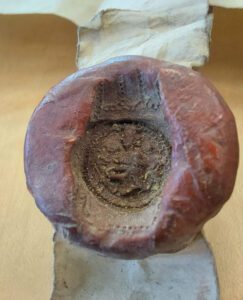
Hampshire Archives: 57M78/E/T98– First attached small pendant seal.
Even though this seal is relatively unclear with dust embedded into its impression, the aspect that makes this seal stand out is the detail of the ring the matrix was a part of. The decoration of links surrounding the impression as well as on the ring’s arms give a more tangible and personable aspect to the material research of seals. Not only does this tell us that the seal’s impression was made with a ring, though with a ring likely worn by its owner most of the time. This is accompanied by the common finding of what is commonly thought to be prints on the reverse side of seals from pressing the matrix into it. Although some prints may be from fingers, those found on the reverse are instead palmprints as wax would be held in the palm when making an impression.

Hampshire Archives: 57M78/E/T98– Reverse of first attached small pendant seal.
Nevertheless, despite medieval seals bearing possibly more interest than those in later centuries, the use of seals developed and carried on into the 18th and 19th centuries. At this point though, they were largely used as seals of closure, meaning to simply seal letters.
Letters included in the papers, letters and telegrams received by James Harris, Earl of Malmesbury and holder of various political offices, include a few interesting examples. Specifically, those received from Sir John Crampton, Minister to Russia, during a time when James was Foreign Secretary in 1858-1859.
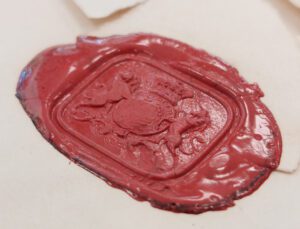
Hampshire Archives: 9M73/447/1/21– Closure seal of letter no. 1.
Included in this collection are examples of how Sir John Crampton used the different seals he had. On the close of the first letter there is a fine impression of a seal owned by his political office as Minister to Russia, impressed onto what can be said to be a very hot pouring of wax from the air bubbles visible.
However, below Sir John Crampton’s personal seal is used on the tenth letter in this collection. This seal, bearing his crest, is an example of how differing types of seals help to often differentiate the nature of the letter or even if the two corresponding would consider each other more as friends rather than political colleagues. Denoting a personal attribute.
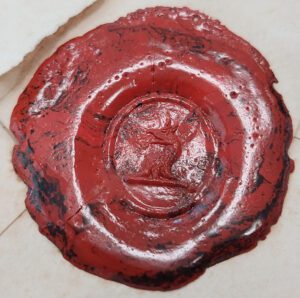
Hampshire Archives: 9M73/447/1/21– Closure seal of letter no. 10.
Seals are an essential component of many documents held in archives, providing interesting and contextual information on the people, institutions and growth of the practice. They’re not only valuable historical artifacts but also essential tools for understanding the authenticating of documents, confirming the identity of individuals and historical transactions. Additionally, they offer the potential of researching the shared identity of a family through the seals that generations bore. As archives continue to grow and evolve, seals will remain an important part of historical records to maintain. Digital imaging and more detailed cataloguing can help expand the field of researching seals and can also aid in appreciating the complexities of the practice of sealing.

Author: Jacob Newbury
Bio: Jacob is currently studying Medieval History at the University of Winchester. He also volunteers in the Winchester College Archive and Wolvesey Castle. Six years of independent research into Jacob’s family history dating back to the tenth century has given him a keen interest in the origins of heraldry, and seals. Jacob is self-taught in medieval Latin in order to transcribe and translate original documents sources from archives. Jacob also uses his skills in computer science alongside his interests in history in order to digitally reconstruct and 3D print historic buildings such as the Old Minster in Winchester.
Find Jacob Newbury on Twitter at @JJNewbs

